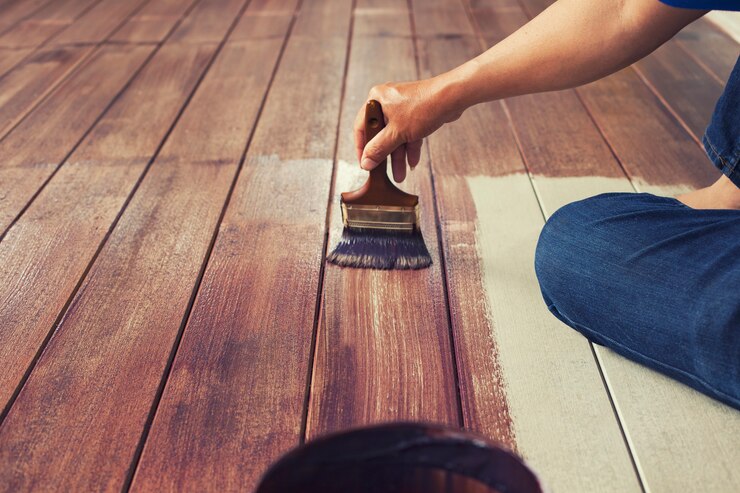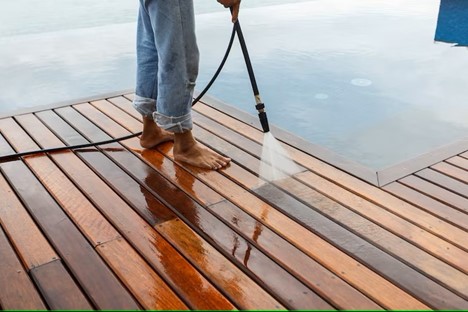What Does Decking Oil Do? Should I Use Stain Instead?
Are you stuck in choosing between decking oil and stain for your timber deck?
The struggle is real, but fear not – we’re here to guide you through this!
In this complete guide, you will learn about two popular finishes. We will explore their features, advantages, and drawbacks.
By the end, you’ll not only know how to make an informed choice but also discover the tips for maintaining and renovating your deck for a timeless appeal.
Decking Oil or Stain Comparison: Which is Best?
Let’s get to the heart of the matter.
Should you opt for decking oil or stain?
To make this decision easy, we’ve prepared a detailed comparison table. It highlights the differences between oils and stains. Have a look!
| Feature | Decking Stains | Decking Oils |
| Nature | Adds vibrant colours, transformative look | Add to natural colours, subtle finish |
| Durability | Outstanding against weather elements | Excellent coverage, decent protection |
| Maintenance | Prone to peeling and cracking | Easy application and maintenance |
| Application Tips | Requires careful application | Thorough cleaning and testing |
Decking Oil Explained
Decking oil is a special liquid that you apply to the wood. Decking oil is like a protective and nutritious coat for your wooden deck.
It makes the wood look good and keeps it safe from the weather.
Decking oil goes beyond surface treatment. Its deep penetration into the wood’s pores shields it against water damage and sun damage with fortified with UV blockers.
Oils also show resistance to mould and fungus.
What it Does
- Protection: Imagine a shield that guards your deck against things like rain, sunlight, and people walking on it. Decking oil does that – it keeps your deck safe from the elements.
- Nourishment: Just like how we need good food to stay healthy, wood needs nourishment too. Decking oil gives your deck the vitamins it needs, keeping it looking fresh and natural.
- Easy to Apply: Putting on decking oil is as easy as spreading butter on bread. You don’t need to hire experts to do it. You can easily do it yourself.
Types of Decking Oils
- Water-Based Oils: These maintain the wood’s natural colour and create an acrylic film on the surface.
- Non-Water Based Oils: Penetrating the wood fibres, these oils offer strong protection.
Choose the Right Decking Oil
The ideal oil for your deck depends on various factors, including
- Usage,
- Exposure to elements,
- Previous oil type, and
- Wood species.
For dark, hardwood timber like Merbau, a lightly tinted oil is preferable to prevent excessive darkening.
Manufacturer recommendations with the timber purchase can guide you on what oil will suit the timber you bought. Otherwise, consult your timber merchant for a specific oil type.
Decking Oil: Pros and Cons
Advantages
- Good Coverage: Protects from moisture and UV exposure.
- Natural Appeal: Nourishes the wood and maintains its natural beauty.
- Easy to Apply: User-friendly application and minimal maintenance.
- Deep Penetration: Easily penetrates the wood, extending its life.
- No Coating, No Slip: Soaks into the wood, leaving it non-slippery.
Drawbacks
- No Constant Redoing: The only catch is, you can’t keep applying it too often. Once it’s on, you can’t change it too frequently.
- Potential Darkening: There’s a possibility of the wood darkening over time.
- Regular TLC Required: Needs regular maintenance, including sanding and reapplication.
Decking Stains Explained
decking stains are magical. These stains come in a rainbow of colours. It breathes new life into lighter or weathered decks.
And the best part!
The magic lasts a long time. Decking stains are a shield against the weather. It stands strong against rain, the sun, and whatever nature throws its way. You get durability and beauty all in one.
Decking Stains: Pros and Cons
Benefits
- Vibrant Colours: Infuses vibrant colours for a transformative look.
- Best Durability: Withstands harsh weather elements.
- Colour Variety: Offers a spectrum of colours to suit your style.
- Surface Shield: This creates a protective barrier on the wood’s surface.
- Speedy Drying: Quick drying, allowing walking on the deck within a few hours.
Drawbacks
- Prone to Peeling: Susceptible to peeling and cracking.
- Apply with Caution: Requires careful and precise application.
When to Stain Your Deck
For pressure-treated wood delivered wet with preservatives, adequate drying time is crucial before staining. The waiting period, ranging from 4-8 weeks post-installation, depends on climate, weather, and sunlight exposure.
Oils Improve Natural Color, Stains Changes Natural Color
Oils
- Oils penetrate deeply into the deck and enhance natural features.
- Oils are ideal for those who appreciate the timber’s existing colour and want to preserve its true beauty.
Stains
- Stains create a surface barrier. It adds colour and minimizes the natural wood appearance.
- Stains are perfect for lighter timbers or those seeking a bold change from weathered, faded hues.
How Long Will Stain and Oil Last
The stronger the pigment, the longer it will last
The pigment quantity is the key factor in the lasting power of stain and oil.
Oils
- Oils contain low pigment levels. These levels are sufficient for UV and foot traffic protection.
- The lower pigment concentration makes oils less strong as compared to stains.
Stains
- Stains, with high levels of pigment, offer complete defence against harsh conditions and foot traffic.
- The higher pigment quantity not only transforms colour but also improves long life. Ensuring a lasting, protective finish.
When to Avoid Each
- Oils: If you frequently change colour and your deck is in a constant state of flux. Then use oil for your deck.
- Stains: Not recommended for those who want to preserve the wood’s natural appearance or have a freshly laid deck.
How Often to Oil or Stain?
Oils
Depending on the type, oils require reapplication every 6 to 18 months.
Water-based and non-water-based oils need different maintenance schedules.
Stains
Transparent stains require yearly re-staining. While solid-pigmented stains offer a longer time of around 5 years.
However, excessive weathering or usage speeds up wear, requiring more regular treatments.
Timber Treatment Explained
Timber treatment involves injecting stable chemicals deep into the cellular structure of wood. This is done to create a strong defence against wood-destroying organisms such as fungi and insects.
Commonly known as ‘timber treatment,’ this process also combines fire-retardant chemicals for enhanced protection.
What to Use for Timber Treatment: Oil or Stain?
When it comes to preserving the integrity of your timber. The choice between decking oil and decking stains is a complex decision.
Both methods offer advantages fitted to specific needs.
5 Benefits of Decking Oil for Timber Treatment
- Excellent coverage, ranging from 8 to 12 square meters per litre.
- Rainproof and suitable for mild foot activity in 4 to 8 hours, depending on the brand.
- Many oils include UV filters for superior protection against UV degradation.
- Nourishes and replenishes the wood’s natural oils, maintaining suppleness.
- Acts from the inside out to prevent cracking, breaking, and warping of decking planks.
5 Benefits of Decking Stains for Timber Treatment
- Forms a protective plastic-like film on the deck’s surface, resisting elements and foot activity.
- Colour pigments limit UV exposure, preventing the greying effects of the sun’s rays.
- Ideal for decking accessories like handrails and spindles, enhancing overall aesthetics.
- Provides strong colour coverage and depth.
- Quick-drying, waterproof, and can be walked on within a few hours.
7 Top Tips to Apply Decking Oils and Stains: Deck Renovation
Applying decking oils and stains is like giving your deck a spa day. It restores and protects. Here are some top tips to make sure your deck gets the VIP treatment:
1. Clean Your Deck Thoroughly
Before it begins, your deck needs a good cleaning. Sweep away the dust. Give it a gentle scrub. Make sure it’s all spick and span.
A clean deck is perfect for your oils or stains.
2. Do a Small Test Before Application
Before going all-in, do a small test. Apply a bit of the oil or stain in an area. Let it dry, see how it looks.
This mini-test can prevent any surprises later on.
3. Follow the Product Instructions
Every product comes with its own set of rules. Read them carefully and follow the instructions.
It ensures that you’re using the product to its fullest potential. Give your deck the treatment it deserves.
4. Watch the Weather
Timing is everything, even for deck treatments. Check the weather forecast. You want a day that’s not too hot, not too cold, and definitely not rainy. Think of it as picking the perfect day for a picnic – your deck will thank you.
5. Place Thin Layers of Oils and Stains, Build Up Gradually
When applying, do not vigorously scrub. Whether it’s oil or stain, a thin and even coat is the key. Don’t drown your deck; let the treatment sink in and work its magic.
6. Pick the Right Timber Treatment
Your deck needs the right treatment. Understand your timber type and choose the treatment wisely. The right one makes all the difference.
7. Repeat for Maintenance
Your deck is a bit like you; it needs regular spa days. Don’t wait until it’s too late. Regular maintenance – be it oiling or staining – keeps your deck in top-notch condition.
Remember these tips. Your outdoor space will thank you with long-lasting beauty and a touch of relaxation.
Deck Maintenance Tips After Oiling or Staining
Maintaining your deck is important for preserving its beauty and structural integrity. Follow these essential tips to ensure your deck stands the test of time:
- Regular Inspection: Periodically check for wear, peeling, or discolouration, addressing issues promptly.
- Gentle Cleaning: Use a soft brush and mild soapy water for routine cleaning to avoid scratching.
- Avoid Harsh Chemicals: Do not use harsh cleaners. Choose products suitable for the deck’s finish.
- Apply Additional Coats: Keep an eye on appearance and reapply coats as needed. Do follow product instructions.
- Handle Stains Instantly: Quickly clean spills with a gentle cleaning solution easy on the coating.
- Use Protective Furniture Pads: Place pads under heavy items to prevent scratches.
- Prevent Water Accumulation: Ensure proper drainage and clear debris to prevent standing water.
- Regularly Trim Surrounding Vegetation: Keep plants trimmed to minimize debris and prevent overhanging branches.
- Seasonal Touch-ups: Consider seasonal touch-ups before harsh weather. Inspect and reapply coats.
- Avoid Heavy Impact: Minimize dragging heavy items to prevent scratches. Lift furniture to avoid damage.
Final Words
Now, you are armed with knowledge about oils and stains. the choice is yours.
Consider the personality of your timber, the desired aesthetic, and the level of maintenance you’re ready for. Choose wisely, whether it’s the subtle touch of decking oil or the bold statement of a vibrant stain.
Go ahead, make an informed decision let your deck shine for years to come.
Ready To Transform Your Deck
Choose quality for your deck. Here are the best products offered by Planet Ark.
Need more guidance or assistance with your decking finish?
Planet Ark is here to help. Connect with us for expert advice.
FAQs
- Can you stain over deck oil?
If your deck has an oil-based stain. Your options are clear. You can either remove it and start fresh or apply the same product again.
If you’re not sure about the existing product. it’s safer to strip it off.
Never use a water-based deck stain over an oil-based one for the best outcome.
- What is a good alternative to decking oil?
Tung Oil is resistant to water. It is an excellent choice for outdoor wood. It prevents drying and decay. Its natural properties make it an ideal option for decking oil.
- Should I stain deck or not?
Let’s make it easy for you to decide. Putting stain on your deck does two things:
- It protects the wood from weather damage and
- Makes it look beautiful.
If you skip the stain, the sunlight can fade the wood, and water will get in. This makes your deck look bad and weak over time.



